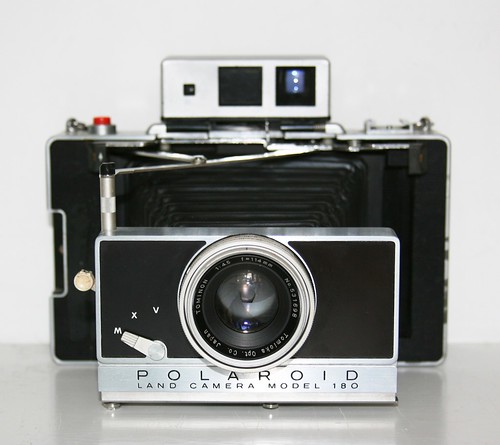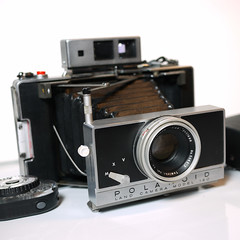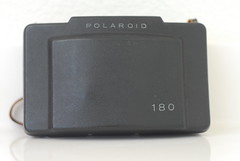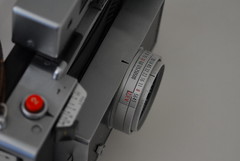Difference between revisions of "Polaroid Land Camera 180"
m (oops, dimension) |
m |
||
| Line 10: | Line 10: | ||
The '''Polaroid Land Camera 180''' looks superficially much like the other folding cameras in the [[Polaroid 100-400 series]]. All use the same 3¼×4¼" instant peel-apart instant film. Like Polaroid's higher-end folding models such as the [[Polaroid Land Model 250|Automatic 250]] and [[Polaroid Land Model 350|350]], the 180 has a metal body with a tripod socket, and similar single-window folding [[Zeiss Ikon|Zeiss]] [[rangefinder (device)|rangefinder]]. So what is different? | The '''Polaroid Land Camera 180''' looks superficially much like the other folding cameras in the [[Polaroid 100-400 series]]. All use the same 3¼×4¼" instant peel-apart instant film. Like Polaroid's higher-end folding models such as the [[Polaroid Land Model 250|Automatic 250]] and [[Polaroid Land Model 350|350]], the 180 has a metal body with a tripod socket, and similar single-window folding [[Zeiss Ikon|Zeiss]] [[rangefinder (device)|rangefinder]]. So what is different? | ||
| − | First the 180 has a 114mm f/4.5 Tominon lens manufactured by [[Tomioka]], with | + | First the 180 has a 114mm f/4.5 Tominon lens manufactured by [[Tomioka]], with fully manual exposure settings. The aperture settings go from f90 to f4.5 with 18 click stops. The shutter speeds run from 1s to 1/500 with B. On the lensboard a lever selects the [[flash sync]] setting, M for bulb or X for electronic flash; "V" is a self-timer setting. |
Also on the lens is an EV window with settings from 5 to 22 EV. The design of the lens rings make it easy to use [[EV]] exposure settings on this camera. The EV numbers can be set at 1/2 EV click stops. Once the correct EV setting has been set, It is very easy to twist both the aperture and shutter dials at the same time to maintain a particular EV number; but it is also easy to set the aperture or shutter independently. The EV scale is similar in concept to that used in the [[Polaroid Pathfinder|Pathfinder]] series of instant cameras. | Also on the lens is an EV window with settings from 5 to 22 EV. The design of the lens rings make it easy to use [[EV]] exposure settings on this camera. The EV numbers can be set at 1/2 EV click stops. Once the correct EV setting has been set, It is very easy to twist both the aperture and shutter dials at the same time to maintain a particular EV number; but it is also easy to set the aperture or shutter independently. The EV scale is similar in concept to that used in the [[Polaroid Pathfinder|Pathfinder]] series of instant cameras. | ||
Revision as of 01:07, 15 July 2011

|
| Polaroid Land Camera 180 image by Graustark (Image rights) |
The Polaroid Land Camera 180 looks superficially much like the other folding cameras in the Polaroid 100-400 series. All use the same 3¼×4¼" instant peel-apart instant film. Like Polaroid's higher-end folding models such as the Automatic 250 and 350, the 180 has a metal body with a tripod socket, and similar single-window folding Zeiss rangefinder. So what is different?
First the 180 has a 114mm f/4.5 Tominon lens manufactured by Tomioka, with fully manual exposure settings. The aperture settings go from f90 to f4.5 with 18 click stops. The shutter speeds run from 1s to 1/500 with B. On the lensboard a lever selects the flash sync setting, M for bulb or X for electronic flash; "V" is a self-timer setting.
Also on the lens is an EV window with settings from 5 to 22 EV. The design of the lens rings make it easy to use EV exposure settings on this camera. The EV numbers can be set at 1/2 EV click stops. Once the correct EV setting has been set, It is very easy to twist both the aperture and shutter dials at the same time to maintain a particular EV number; but it is also easy to set the aperture or shutter independently. The EV scale is similar in concept to that used in the Pathfinder series of instant cameras.
Links
- Polaroid 180 at the Land List
- Polaroid 180 group on Flickr

|
| image by Russ Morris (Image rights) |

|
| Different cover compared to Polaroid 100-400 series image by joanseda (Image rights) |

|
| EV setting window on lens barrel image by joanseda (Image rights) |